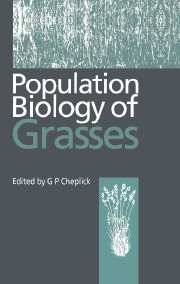Book contents
- Frontmatter
- Contents
- Contributors
- Preface
- Darwin revisited: approaches to the ecological study of grasses
- Part one Population variation and life history patterns
- Part two Ecological interactions
- 8 Plant–plant interactions in grasses and grasslands
- 9 Competition between grasses and woody plants
- 10 Fungal endophyte infection and the population dynamics of grasses
- 11 Arbuscular mycorrhizas and the population biology of grasses
- Part three Population biology of specific groups
- Index
9 - Competition between grasses and woody plants
Published online by Cambridge University Press: 14 September 2009
- Frontmatter
- Contents
- Contributors
- Preface
- Darwin revisited: approaches to the ecological study of grasses
- Part one Population variation and life history patterns
- Part two Ecological interactions
- 8 Plant–plant interactions in grasses and grasslands
- 9 Competition between grasses and woody plants
- 10 Fungal endophyte infection and the population dynamics of grasses
- 11 Arbuscular mycorrhizas and the population biology of grasses
- Part three Population biology of specific groups
- Index
Summary
Introduction
Grasses are good models for studying the role of competition in forming ecological patterns because they contribute to obvious patterns, such as the boundary between prairie and forest. Further, grasses are suitable for short-term experiments because they achieve full size and reproductive maturity quickly. In this review I examine competition in the context of the replacement of grasses by trees along gradients of increasing evapotranspiration or productivity. Grasses are also replaced by shrubs as grassland merges into desert, and I have drawn examples from that system where appropriate.
The boundary between grass and woody vegetation is especially interesting because its causes are unknown. The boundary is associated with very small differences in climate, making it likely to be highly responsive to global change (Emanuel, Shugart & Stevenson, 1985). Its abrupt nature may reflect feedbacks between plants and resources (Wilson & Agnew, 1992). Temporal shifts between grass and woody vegetation are also often sudden, prompting Westoby, Walker & Noy-Meir (1989) to suggest that grassland vegetation dynamics are best described using state and transition models. In spite of many examples of competition between grasses and trees, however, it is not at all clear how competition contributes to the boundaries between them.
Here I review what features distinguish grass competition from competition involving other kinds of plants. Because the grass plant has a unique morphology, I examine the possible contribution of niche partitioning to the distribution of grasses. General models relating species distributions to competition are evaluated using mostly experimental evidence. The role of feedbacks is assessed. Finally, I try to identify promising avenues for future research.
- Type
- Chapter
- Information
- Population Biology of Grasses , pp. 231 - 254Publisher: Cambridge University PressPrint publication year: 1998
- 43
- Cited by



